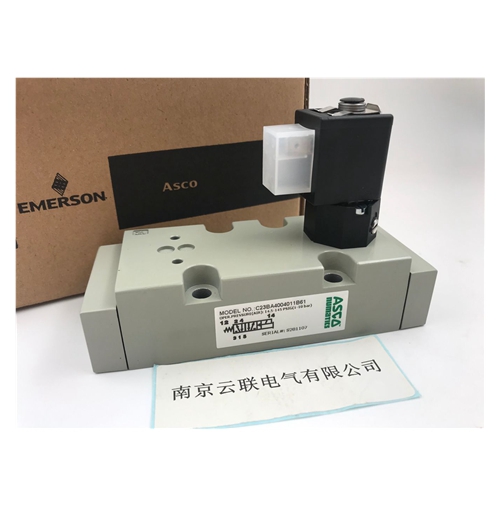如何正确维修ASCO防爆电磁阀方法?
添加时间:2024-03-25 09:10:30
如何正确维修ASCO防爆电磁阀方法?

预防性维护主要是为确保调压器可靠运行而在不发生故障时采取的预防性维护措施,包括ASC防爆电磁阀在现场安装使用
时采取的一系列预防性措施;和ASCO防爆电磁阀的故障维护,即当调压器出现故障时调压器不能满足使用要求时所进行的一系
列维护,通常在车间内完成,也可以直接在工r进行。特殊情况下的管道。
预防性维护,预防性维护是指控制阀故障之前的计划维护。可以理解为日常维护,通常包括以下任务。
1.1泄压管线。由气动控制阀的组合或安装不当弓|起的各种应力,例如高温介质弓|起的热应力,固定式单座控制阀在安装过
程中因固体力不平衡引起的应力以及人为的确定性。以及这些碰撞导致的管道。这些应力会影响ASCO防爆电磁阀及其管道,这
些应力很容易影响调节阀。在严重的情况下,它会影响调节系统本身,导致阀杆和导向件变形,而阀杆和导向件无法与阀座对
齐。分体阀体调节阀可能导致阀体法兰脱离;应力也可能导致阀座泄漏。因此,有必要确保可以随时避免或消除应力,并且应力
应从调节阀上移开。
1.2检查轴承状况。ASCO防爆电磁阀的好位置是使阀杆的行程方向和执行器位于阀体上方的垂直平面上。如果必须将调节
器安装在阀杆水平移动的位置,或者当阀杆的移动方向和水平面倾斜-定程度时,应在调节器的正常工作状态下支撑执行器。如
果没有安装支撑或安装支撑, 安装不当会导致阀杆和阀座的调节不-致,很容易引起差异或引起填料泄漏和其他故障。即使调节
器具有固定的支撑措施,也应定期检查,例如每2到3个月检查- -次。
常闭式:线路通电时,吸住先导阀芯,打开先导孔,解除阀门上腔,下腔内的介质压力推动活塞,电磁阀开启;当线国断电
时,先导阀芯被弹簧复位,先导孔关闭,阀的上腔被活塞孔和复位弹簧的推力加压,电磁阀关闭。
常开型:当线罔通电时,先导孔关闭,阀的上腔由活塞孔和回位弹簧的推力加压,电磁阀关闭。断电时,先导阀芯被弹簧复
位,先导孔打开,阀门上腔卸压,下腔中压推动活塞,电磁阀打开。信号反馈:当阀[ ]开启时,信号公共线和开启信号线连接:
当阀门关闭时,信号公共线和关闭信号线连接。信号反馈电磁阀选择规范:
1.电磁阀的主要控制参数有直径、设计公称压力、介质允许温度范围、接口尺寸等。
2.电磁阀使用电磁铁推动阀[ ]的开启和关闭,通常用于直径从DN15到DN300的两位控制,特别是用于连接、切断或
How to correctly repair ASCO explosion-proof solenoid valves?
Preventive maintenance is mainly a preventive maintenance measure taken to ensure the reliable operation of the voltage regulator without failure, including the installation and use of ASC explosion-proof solenoid valves on site
A series of preventive measures taken at the time; Fault maintenance of ASCO explosion-proof solenoid valves, which refers to a series of actions taken when the regulator fails and cannot meet the usage requirements
Column maintenance is usually completed in the workshop or can be directly carried out in the workshop. Pipeline under special circumstances.
Preventive maintenance refers to planned maintenance prior to control valve failure. It can be understood as daily maintenance, usually including the following tasks.
1.1 Pressure relief pipeline. Various stresses caused by the combination or improper installation of pneumatic control valves, such as the thermal stress caused by high-temperature medium bows, can occur when a fixed single seat control valve is installed
The stress caused by the imbalance of physical strength during the process and the uncertainty caused by human factors. And the pipes caused by these collisions. These stresses will affect ASCO explosion-proof solenoid valves and their pipelines, which
Some stresses can easily affect the regulating valve. In severe cases, it can affect the regulating system itself, causing deformation of the valve stem and guide components, which cannot align with the valve seat
Qi. The split valve body regulating valve may cause the valve body flange to detach; Stress can also cause valve seat leakage. Therefore, it is necessary to ensure that stress can be avoided or eliminated at any time, and that stress
It should be removed from the regulating valve.
1.2 Check the condition of the bearings. The good position for ASCO explosion-proof solenoid valves is to position the direction of valve stem travel and the actuator on the vertical plane above the valve body. If it is necessary to adjust
The actuator should be supported in the normal working state of the regulator when installed in the position where the valve stem moves horizontally, or when the direction of valve stem movement and the horizontal plane tilt to a certain degree. as
If there is no installation support or installation support, improper installation can lead to improper adjustment of the valve stem and valve seat, which can easily cause differences or lead to packing leakage and other faults. Even if adjusted
The device has fixed support measures and should also be inspected regularly, such as every 2 to 3 months.
Normally closed: When the circuit is energized, the pilot valve core is sucked in, the pilot hole is opened, and the upper chamber of the valve is released. The medium pressure in the lower chamber pushes the piston, and the solenoid valve opens; When the line country loses power
At this time, the pilot valve core is reset by the spring, the pilot hole is closed, the upper chamber of the valve is pressurized by the thrust of the piston hole and the reset spring, and the solenoid valve is closed.
Normally open type: When the line is not energized, the pilot hole closes, and the upper chamber of the valve is pressurized by the thrust of the piston hole and return spring, and the solenoid valve closes. When the power is cut off, the pilot valve core is spring-loaded
Position, pilot hole open, valve upper chamber depressurizes, lower chamber medium pressure pushes piston, solenoid valve opens. Signal feedback: When the valve [] opens, the signal common line is connected to the open signal line:
When the valve is closed, the signal common line is connected to the closing signal line. Selection specifications for signal feedback solenoid valves:
The main control parameters of an electromagnetic valve include diameter, design nominal pressure, allowable temperature range of the medium, interface size, etc.
2. Electromagnetic valves use electromagnets to push the opening and closing of valves, usually used for two position control with diameters ranging from DN15 to DN300, especially for connecting, cutting, or